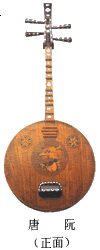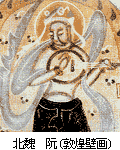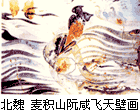Ruǎn
Ruǎn has a round sound box, 12 sound posts, 4 strings. It has been used as solo, ensemble and accompaniament for singing and dancing with its strong expressive power.
 It is said that in 115 B.C. Emperor Wu of Han Dynasty married one of his relatives to the king of Wusun State (where today’s Uzbenkstan is). He ordered his craftsmen to make a new type of instrument, which had a round sound box, 12 posts and 4 strings for the girl to be married. It was called “Qin-Pipa” at that time, which is today’s Ruan. Ruan is divided into three types in accordance with its size, namely small, medium and large -sized Ruan.
It is said that in 115 B.C. Emperor Wu of Han Dynasty married one of his relatives to the king of Wusun State (where today’s Uzbenkstan is). He ordered his craftsmen to make a new type of instrument, which had a round sound box, 12 posts and 4 strings for the girl to be married. It was called “Qin-Pipa” at that time, which is today’s Ruan. Ruan is divided into three types in accordance with its size, namely small, medium and large -sized Ruan.
Some people believe that Ruan was brought into China from  middle Asia via Qiuci State in the 4th century.
middle Asia via Qiuci State in the 4th century.
“7 Scholars of Bamboo Forest” in the Eastern Jin Dynasty (317-420) were very much respected by people of that time. Among them, Ruan Xian was a master of Ruan playing. Some people held that the instrument was named after him.
We can see Ruan on frescoes in caves of Maiji Mountain in Gan Su and in Dunhuang of Northern Wei period (386-534), they are similar to what Ruan looks like today as shown in  the pictures below.
the pictures below.

Fresco on Maiji Mountain Fresco in Dunhuang
(Northern Wei) (Northern Wei)
Much to our regret, Ruan was not used since Song Dynasty and as a result, no notation of old Ruan pieces has been reserved. It was in the last 60 years, quite a number of Ruan scores have been composed.
Famous Ruan Pieces
1、《玉楼月Moon over Jade Mansion》, a Ruan Solo, composed by Professor Ning Yong on basis of an old score of the same name. The piece describes an enchanting night of songs and dances in the Jade Mansion.
2、《丝路驼铃Camel Bells on the Silk Road》, a solo with a large-sized Ruan, also composed by Ning Yong on basis of a poem by Zhang Ji of Tang Dynasty, the music portrays such two lines of the poem: the sound of camel bells is drifting over the desert, camels should have reached Anxi with white silk. The piece adopts local folk factors in Xinjiang, especially the hand drum, the percussion used to accompany dancing. The music shows how the gloomy and depressed merchants travelled on the vast desert with camels.
3、《满江红The Red River》 was one of the set tunes for people to fill in verses,the most famous one was filled in by Yue Fei, a national hero and a marshall in Southern Song period (1127-1279). He had been fighting the invaders for ten years, on the day he was leading the trip for a decisive battle, 12 orders came one after another within one day from the Emperor and asked his to withdraw the troops. Because he insisted fighting, he was percecuted and finally killed. As the original verse, this music piece is full of power and grandeur.
4、《睡莲Sleeping Lotus》portrays the tranquil ablooming of sleeping lotus in water and its cleanness with a deep and ambigious color.
5、《山韵The Charm of Mountains》, a medium-sized Ruan concerto composed by Zhou Yuguo. It depicts the overarching power of mountains, the ambiguity of waters and straight forwardness of peaks. The three chapters reveal how nature can stir up people and shock their souls.
